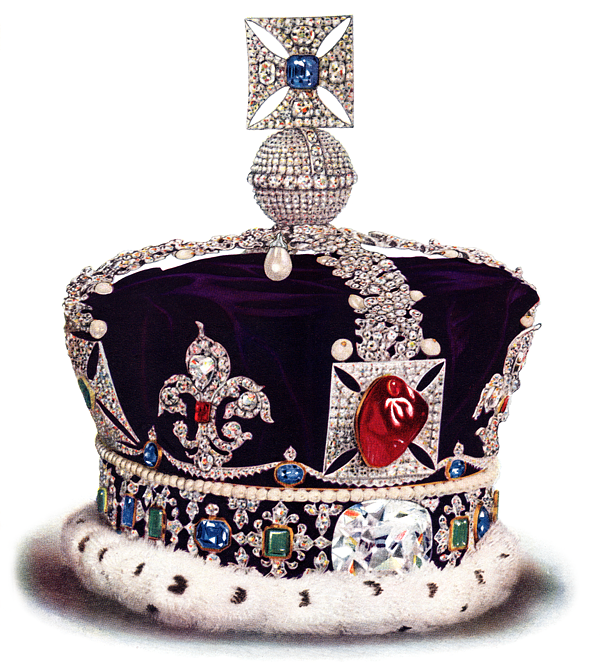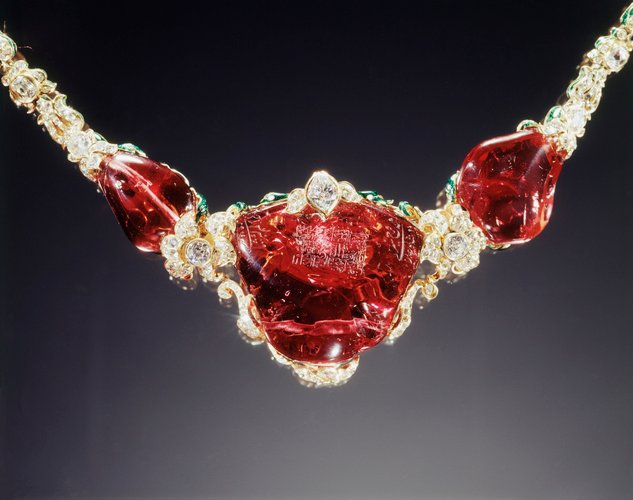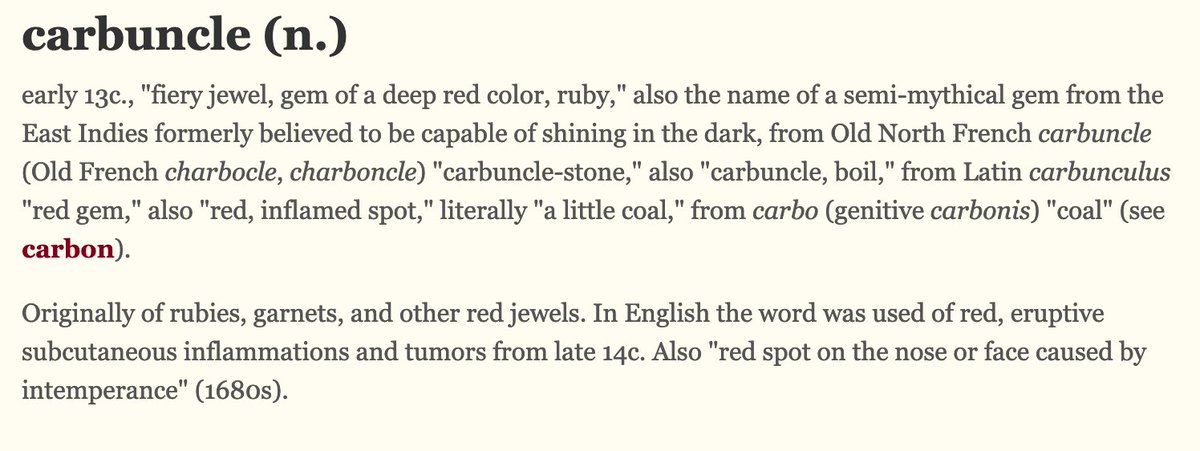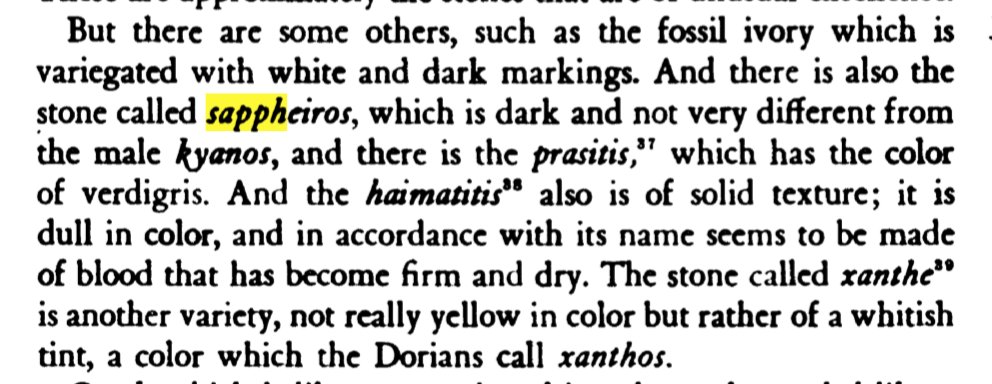when corundum synthesis was perfected, a long-held marker of status and wealth was shockingly destabilised... OR WAS IT? Today I will bust open the Ruby Myth and show rubies and sapphires have never existed. Vote corundum, the earthly representative of a legend https://twitter.com/MineralCup/status/1310491875963318273">https://twitter.com/MineralCu...
or in other words I& #39;m going to talk about how what& #39;s meant by "ruby" and "sapphire" over the course of human history is surprisingly slippery stuff, and why that& #39;s interesting
The reason there are so many references to rubies and to a lesser extent sapphires in history and folklore is, to a large extent, that those terms used to be used much, much more loosely. For example, this is is the Black Prince& #39;s Ruby. actually, though, it& #39;s a spinel
Were the English mistaken in the identity of the stone? were they deceived? nope, there was then no distinction made between the ruby and the spinel. There& #39;s no particular reason why corundum should have kept the appellation "ruby" while spinel was disinherited.
Like, people knew spinel was slightly different to corundum, and gave it a different name (Balas ruby) but in the same way you might be aware that particularly deeply coloured rubies from Burma are called "pigeon& #39;s blood rubies". you don& #39;t think of them as a distinct mineral
A lot of famous rubies of history are spinel. The Timur Ruby, a gem with an incredible history, is a spinel. But historically, culturally, in its time spinel WAS ruby. It didn& #39;t so much get discovered as get the sack
https://www.rct.uk/collection/themes/exhibitions/victoria-albert-art-love/the-queens-gallery-buckingham-palace/the-timur-ruby-necklace">https://www.rct.uk/collectio...
https://www.rct.uk/collection/themes/exhibitions/victoria-albert-art-love/the-queens-gallery-buckingham-palace/the-timur-ruby-necklace">https://www.rct.uk/collectio...
Nadir Shah of Iran engraved the Timur Ruby thus: "This (is) the ruby from among the 25,000 genuine jewels of the King of Kings... which in the year 1153 [1740 AD] from the jewels of Hindustan reached this place."
image: https://torontoguardian.com/2018/08/emperors-jewels-exhibition-aga-khan-museum/">https://torontoguardian.com/2018/08/e...
text: https://www.gemselect.com/other-info/timur-ruby.php">https://www.gemselect.com/other-inf...
image: https://torontoguardian.com/2018/08/emperors-jewels-exhibition-aga-khan-museum/">https://torontoguardian.com/2018/08/e...
text: https://www.gemselect.com/other-info/timur-ruby.php">https://www.gemselect.com/other-inf...
like, are you going to correct him or
It wasn& #39;t just corundum and spinel; pretty much any red stone could be described as a "ruby". What does "ruby" mean, anyway? just "red".
https://www.etymonline.com/word/ruby ">https://www.etymonline.com/word/ruby...
https://www.etymonline.com/word/ruby ">https://www.etymonline.com/word/ruby...
"carbuncle" was used in a similar way to "ruby" to mean any red stone. Honestly I don& #39;t think we stopped saying "carbuncle" because we were so into precision, we dropped it because it was too gross; it had started meaning "boil, lesion, zit"
What about "sapphire"? Unlike "ruby", this wasn& #39;t a broad label for any clear blue stone that became more specific with time; it& #39;s referred to a number of different clearly distinct gems, possible due to misinterpretation of ancient texts.
Theophrastus talks about a dark blue stone called "sappheiros", but he says it& #39;s easy to carve into seals, opaque, and sometimes flecked with gold. we have lots of examples of lapis lazuli sealstones; here& #39;s one contemporary with Theophrastus (300BC ish).
https://www.britishmuseum.org/collection/object/G_1867-0507-545">https://www.britishmuseum.org/collectio...
https://www.britishmuseum.org/collection/object/G_1867-0507-545">https://www.britishmuseum.org/collectio...
i do not wish to leap to conclusions about the identity of the mysterious "sappheiros", however,
Theophrastus describes "sappheiros" as being similar to a stone called "kyanos", but darker in colour; it& #39;s pretty likely they& #39;re different grades of lapis lazuli.
theophrastus is rad btw. he feels really contemporary. dude is just describing things and trying to figure out how they work and vibing. a true scientist. you can access the translation of his "on stones" i& #39;ve been using here: https://kb.osu.edu/dspace/bitstream/handle/1811/32541/THEOPHRASTUS_CALEY.pdf?sequence=1">https://kb.osu.edu/dspace/bi...
Pliny is the smug New Atheist guy who& #39;s always going on about Western Civilisation and hoarding hydroxychloroquine. Theophrastus is the botany postdoc who& #39;s quietly sectioned off a corner of the greenhouse for psychedelic plants. read Theophrastus https://www.theatlantic.com/science/archive/2016/06/the-man-who-invented-botany/485780/">https://www.theatlantic.com/science/a...
"invented botany" is a bit much but the article otherwise described Theophrastus& #39; charm very well

 Read on Twitter
Read on Twitter


![Nadir Shah of Iran engraved the Timur Ruby thus: "This (is) the ruby from among the 25,000 genuine jewels of the King of Kings... which in the year 1153 [1740 AD] from the jewels of Hindustan reached this place." image: https://torontoguardian.com/2018/08/e... text: https://www.gemselect.com/other-inf... Nadir Shah of Iran engraved the Timur Ruby thus: "This (is) the ruby from among the 25,000 genuine jewels of the King of Kings... which in the year 1153 [1740 AD] from the jewels of Hindustan reached this place." image: https://torontoguardian.com/2018/08/e... text: https://www.gemselect.com/other-inf...](https://pbs.twimg.com/media/Ei_nX46U8AAmwTl.jpg)








